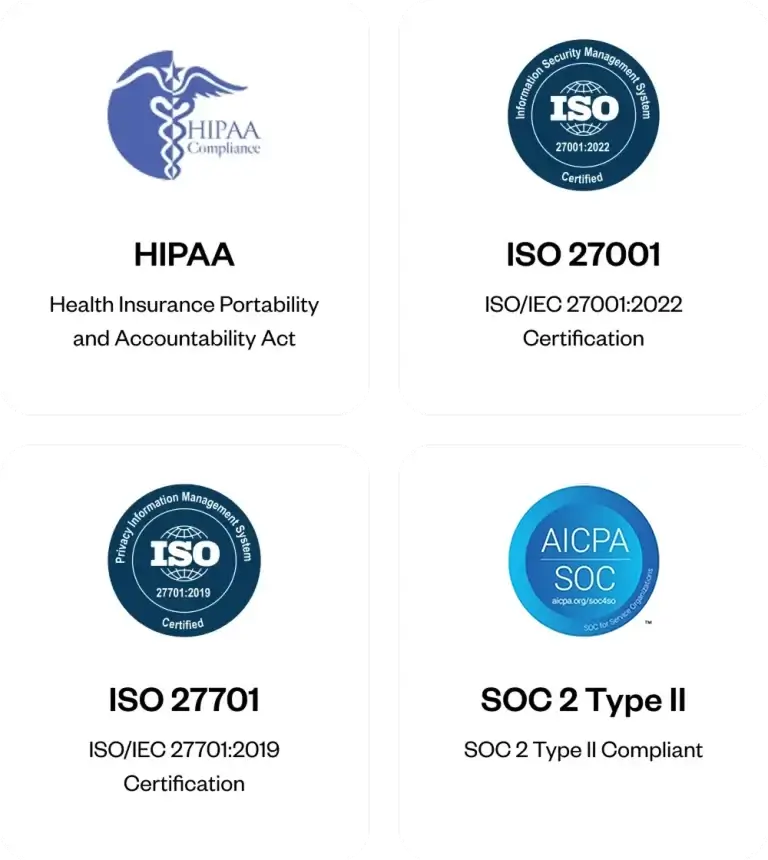Executive summary
Call center productivity is the lifeblood of any customer-centric business. Did you know a recent study revealed that a mere 1% improvement in efficiency can translate to millions of dollars in annual savings? That’s right. Likewise, are you aware that call centers are among the leading employers in the United States? Nearly 3 million Americans work for them. Optimizing your call center isn’t just about keeping agents busy; it focuses on empowering them to deliver outstanding service while maximizing your bottom line.
This comprehensive blog simplifies many riddles to call center success. As you read through, you will explore aspects such as call center productivity metrics, why call center agent productivity is important and how to improve it. These facets are interdependent. The blog will also guide you to understand the key KPIs, proven strategies, and actionable tips to streamline operations, boost agent performance, and transform your customer interactions into positive experiences that keep your business thriving.
Related must-reads:
Customer service in a call center: A detailed guide
31 Call center metrics and KPIs to enhance the CX
10 Strategies for call center operations excellence in 2024
Call center software – A Complete Guide [2024]
What is call center productivity?
The definition of call center productivity is much more than responding or answering calls per agent. Neither is it a fancy term reflecting the number of calls the facility handles daily. The true essence of call center productivity underlines the holistic measure of how efficiently and effectively it operates to achieve its core objectives. According to a survey, when asked what they value most regarding customer service, 90% of consumers voted for getting a prompt response. On the other hand, a mere 26 % of customers responded favorably when asked if they think customer service centers give excellent help, according to a research called ‘Call Center Statistics You Should Know’. The stakes are high, and businesses that prioritize call center optimization are the ones setting themselves up for success.
Related read: Contact centers vs. call centers: What’s the difference?
Let’s break down the meaning of call center productivity by applying a magic formula:
Quality interactions + efficient use of resources = satisfied customers and thriving business
This equation highlights the two key aspects of call center productivity:
- First, delivering exceptional customer service that resolves inquiries quickly and leaves a positive lasting impression.
- Second, optimizing resources—both human (your agents) and technological—to ensure a smooth workflow and minimize wasted time.
By mastering these two facets, you harness the true potential of your call center, transforming it from a cost center into a revenue-generating powerhouse.
Thus, consider it a multifaceted metric encompassing the efficiency and effectiveness of your entire operation. Perceive it as a balancing act between keeping your agents busy and ensuring they have the tools and resources to resolve customer issues swiftly and comprehensively.
If you are bracing up to enhance its productivity, focus on a few key features that can contribute to achieving the desired goals. The list includes primarily three factors:
- Agent efficiency: One of these metrics is first call resolution (FCR), which shows the frequency with which a problem is handled on the initial contact. The FCR rate of outstanding call centers is 74% or above. Likewise, another metric, average handling time (AHT) measures the time it takes to resolve a call.
- Customer satisfaction: Satisfied consumers result in decreased call volume and increased customer loyalty. Tracking metrics such as Customer Satisfaction Scores (CSAT) and Net Promoter Scores (NPS) helps gauge customer sentiment.
- Operational efficiency: Streamlined workflows, effective call routing, and readily available resources all contribute to a smooth call center operation, minimizing wasted time and maximizing agent output.
How to calculate call center productivity?
Among several other queries, one question that can keep you on the toes is, ‘How do you calculate call center productivity? ‘ The answer can clarify whether your call center is hitting the productivity jackpot or not. Here are two vital metrics that paint a clear picture:
Related read: What is contact center compliance? [+Checklist]
Overall call resolution rate
This metric reveals how many customer inquiries your agents resolve on the first try without needing to transfer the customer or schedule a follow-up. A high call resolution rate means fewer frustrated customers calling back and more efficient use of your agents’ time.
Here’s a simple formula:
Overall call resolution rate = (number of calls resolved on first contact) / (total number of calls received) x 100
For example, your agents resolve 80 out of 100 calls on the first try. It translates to an 80% Call Resolution Rate – an impressive feat!
Ratio of output to input:
As the phrase suggests, consider it a cost-benefit analysis for your call center. It works like a business report card. Under this category, you must look at the value, i.e., output, your agents are generating compared to the resources, i.e., input, invested.
Output could include:
- The number of calls or issues resolved
- Enhanced customer satisfaction scores
- Revenue generated through call center interactions
Input can be an umbrella term covering agent salaries and training costs besides technology investments. By calculating the ratio (output divided by input), you can see if your call center is operating competently and generating a positive return on investment (ROI). A high ratio indicates your call center effectively delivers value for your business. Instead of getting intimidated by these calculations, remember they are designed to be clear and actionable, even for math-averse folks.
The goal is to achieve a high output-to-input ratio. This means your call center is generating positive results (output) for the resources you’re putting in (input). You may learn a lot about the strength or weaknesses of your call center by keeping tabs on these significant metrics. This will help you using data-driven tactics and, ultimately, reaching the zenith of call center productivity targets.
How do you measure call center agent productivity?
Let’s now examine the indicators used to assess call center agent productivity. Discover the comprehensive set of metrics available on your agent’s dashboard, offering valuable insights into their skills, performance and customer engagement capabilities.
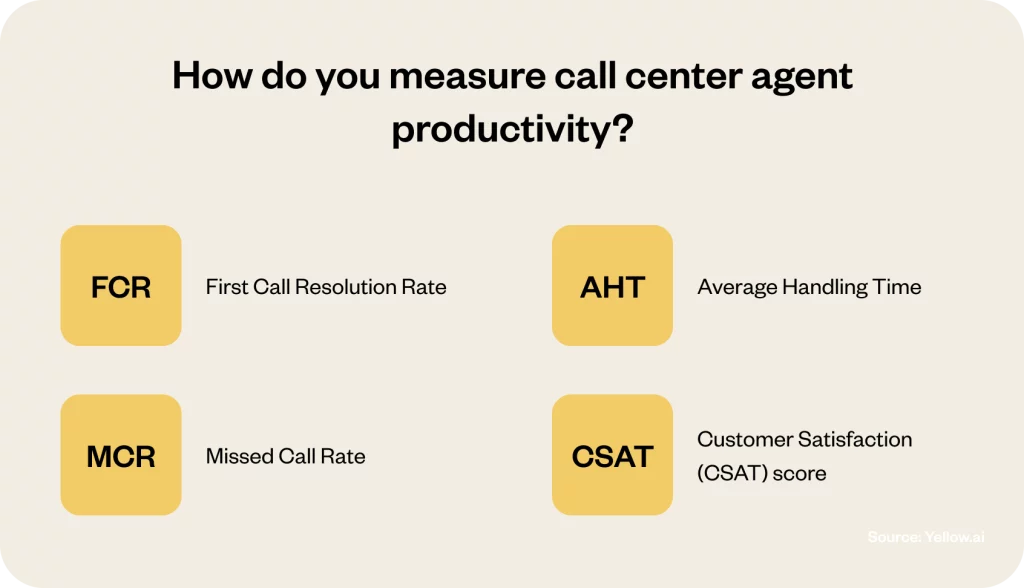
1. First Call Resolution Rate (FCR)
This metric estimates how often agents settle customer issues on the first call without transfers or follow-ups. A whopping 93% of customers would pay more to do business with brands that refrain from compelling them to repeat themselves. Thus, it underlines the importance of FCR and a high score indicates efficient problem-solving skills and reduces customer frustration.
2. Average Handling Time (AHT)
This metric tracks the typical amount of time an agent spends on a single call, beginning with the response and ending with goodbye. While a lower AHT might seem ideal, it shouldn’t come at the expense of quality customer service. Finding the sweet spot between speed and attentiveness is critical. An average AHT in the sector is little more than 6 minutes.
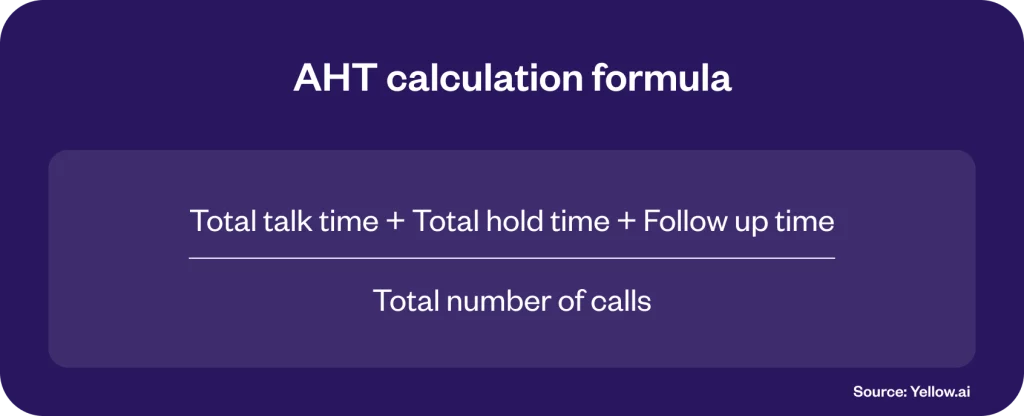
Meanwhile, it is important to mention that the conventional AHT calculations typically include total conversation time, total hold time, and the total number of calls processed. On the other hand, this strategy might not work for contemporary support companies such as virtual contact centers.
3. Missed call rate
Nobody likes it when their calls go unreturned. Businesses squander chances to attract customers and give excellent service. Callers feel unappreciated. Everybody is angry because it’s a lose-lose situation. For 30% of respondents to the State of Global Customer Service study, the inability to speak with a live person is the most annoying aspect of poor customer service. Thus, this metric keeps a tab on the percentage of calls that go to voicemail due to agent unavailability. A high missed call rate can signal staffing shortages or inefficient call routing.
4. Customer Satisfaction (CSAT) score
This metric goes straight to the heart of the matter – how happy are your customers with the service they received? A survey found that 80% of customer service firms use CSAT to measure and enhance customer experience. CSAT surveys capture customer feedback after an interaction, providing valuable insights into agent communication skills and problem-solving abilities.
By closely monitoring these agent-specific metrics, you can identify areas for improvement, provide targeted coaching, and empower your agents to become customer service champions. Remember, content and well-equipped agents translate to a thriving call center operation!
What are the reasons for low call center productivity?
Even the most committed call center staff might experience difficulties when faced with internal obstacles. Here are a few typical explanations for why productivity in call centers could be low.
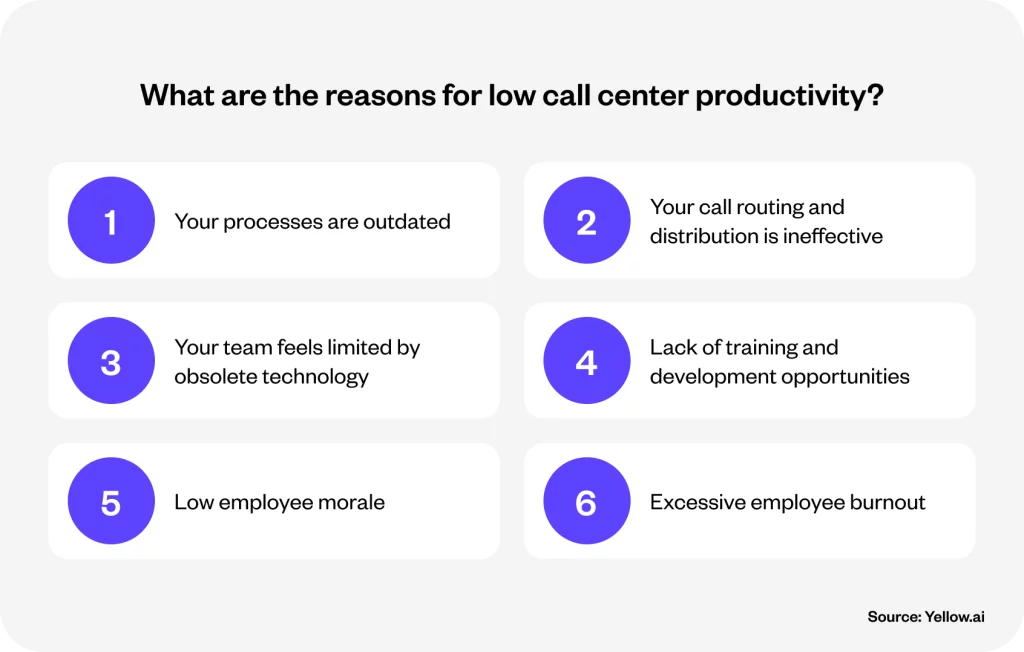
1. Your processes are outdated
Change is the law of nature and one must adapt and adopt with the changing time. Clinging to outdated call-handling procedures can create bottlenecks and slow agents down. Think about how inefficient it would be to rely on clumsy software or go through a complex maze of papers. Modernizing your processes with streamlined workflows and user-friendly technology can significantly boost productivity.
2. Your call routing and distribution is ineffective
Many of us might have experienced it when our calls get suddenly diverted to the wrong CS agent, and we need to explain the whole scenario again. Calls repeatedly sent to the incorrect agents cause customers frustration and loss of time. A poorly designed call distribution system could cause some agents to be swamped while others sit idle. Quicker resolution times and satisfied customers are the results of a well-planned call routing strategy that directs incoming calls to the agents most suited to handle them.
3. Your team feels limited by obsolete technology
Call center jobs are taxing, and it is natural for agents to feel stuck with outdated and obsolete technology. Slow systems, unreliable and erratic connections, and limited functionalities can restrict agent performance and trigger unwanted frustration. It might appear unnecessary, but investing in robust call center software with advanced and helpful features like call recording, call analytics, and easy-to-use interfaces proves worthwhile in the long run. This allows agents to give their full attention to providing outstanding customer service, which is their strength.
4. Lack of training and development opportunities
Skills come from knowledge, which is a power, especially in a fast-paced call center environment. Agents who lack proper training or have yet to be given opportunities to hone and upgrade their skills from time to time are more likely to grapple with complex inquiries. Investing in comprehensive periodical training programs on product knowledge, communication techniques, and problem-solving skills equips agents to handle customer issues confidently and efficiently.
5. Low employee morale
If you want high productivity at your call center, you can’t have a workforce with low employee morale. Disengaged and unhappy employees are unlikely to go the extra mile. Several factors, such as inadequate compensation, unnecessary macro-management, lack of recognition, or a negative work environment, can contribute to low morale. You can witness a welcome change by fostering a positive work culture. This ecosystem needs to be conducive to opportunities for growth, recognition programs, and a focus on employee well-being. It can significantly boost self-esteem and, as a result, call center productivity.
6. Excessive employee burnout
During peak hours, call center work can be taxing, taking a toll on the employees’ mental and physical health. The constant pressure to meet the targets, high call volume, agitated and abusive customers, and limited to no breaks can lead to burnout. All these are causative factors impacting agent performance. To rectify this, execute effective call center scheduling practices, promote healthy work-life balance, and offer stress management resources to help prevent burnout and keep your agents performing at their best. You can take the necessary actions once you’ve identified these obstacles to call center productivity. The solution lies with you in creating a favorable work environment. The aim is to promote efficiency, uplift your team, and meet the needs of both agents and consumers.
How to increase call center productivity?
Now that we’ve identified the culprits behind low productivity let’s explore actionable strategies to get your call center firing on all cylinders. Here is a list of six practical measures one can use to increase call center poroductivity.
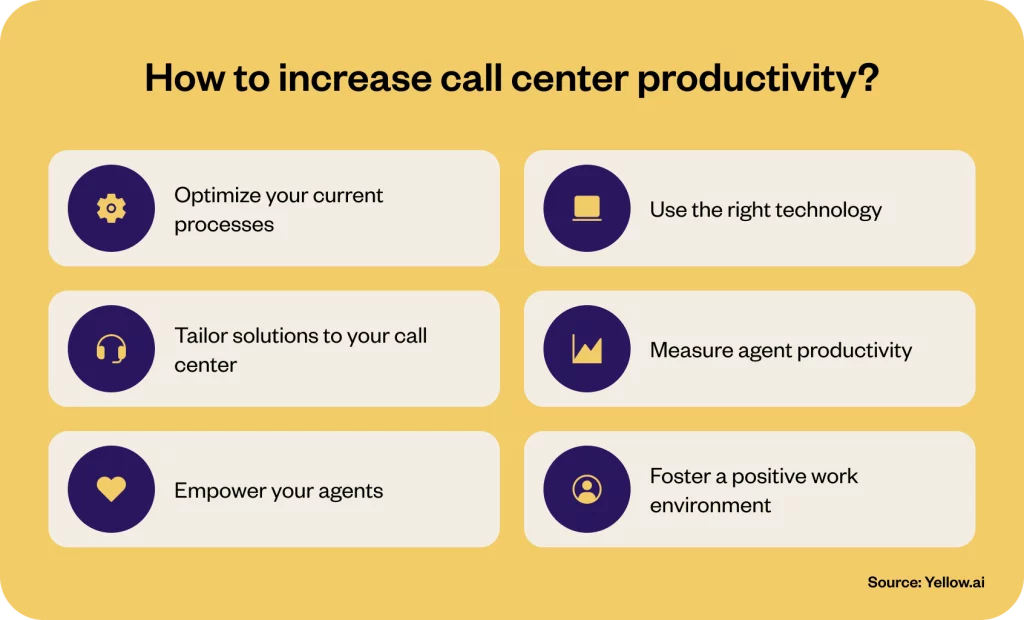
1. Optimize your current processes
We have just learnt how outdated workflows are a productivity loss. It is draining to have effective communication with the customers for the agents when the systems reflecting the customer’s previous records keep crashing down. Conduct an in-depth review of your call center processes – from call routing to data entry – and identify areas for improvement. Consider streamlining workflows, implementing automation tools for repetitive tasks, and creating clear, concise call scripts. Research conducted a few years ago estimated that the worldwide artificial intelligence business will be worth $2,222.5 million by 2025. It’s time to embrace the latest technology. A testament to this is the wide integration of automation through advanced AI in customer service.
2. Use the right technology
Instead of fretting about the technological innovations, be open and implement the right technology. According to Gartner, the percentage of automated contacts with agents will reach around 10% by 2026, a fivefold increase from what it was in 2022. It can be a game-changer for your call center productivity.
Invest in a modern call center platform that offers features like:
- Interactive Voice Response (IVR): Allows customers to self-serve for basic inquiries, freeing up agents for more complex issues.
- Knowledge management systems: Equips agents with easy access to product information and troubleshooting resources.
- Call recording and quality monitoring: Provides valuable insights into agent performance and areas for improvement.
For example, the leading international bank, HSBC, has used the Automated Quality Management system for its reviews. It was intended to speed up sales call reviews and highlight opportunities for customer conversation enhancement.
3. Tailor solutions to your call center
After identifying the areas hindering your efficiency, you will execute corrective measures. Nevertheless, be prudent here that what has worked for your competitor would serve you the purpose. There’s no one-size-fits-all approach to call center productivity. Invest time to analyze your specific needs and challenges before implementing new strategies. For instance, a high-volume call center dealing with simple inquiries can benefit significantly from an efficient IVR system, while a luxury brand offering personalized service can prioritize well-trained agents prepared to handle complex customer requests.
Outstanding voice automation—AI that sounds like humans

4. Measure agent productivity
Make the maximum use of the data, instead of going with a guessing game! Track key performance indicators (KPIs) like average handling time (AHT), first call resolution rate (FCR), and customer satisfaction score (CSAT) to identify areas for improvement. Utilize these metrics to set realistic goals for the call center agents and measure their performance and progress over time.
5. Empower your agents
Don’t underestimate the power of a motivated workforce. Provide agents with comprehensive training on products, services, and communication techniques. Recognize and reward top performers and offer opportunities for advancement. Feeling valued and empowered makes a world of difference in agent performance. You may introduce and implement popular recognition programs like Employee of the Month and Years of Service Awards.
For example, Zappos, a renowned online retailer, is known for its exceptional customer service culture. They invest heavily in agent training and empowerment, nurturing a positive work environment where agents feel confident tackling customer inquiries.
6. Foster a positive work environment
Just as a satisfied customer is loyal, a happy agent is a productive call center agent. Build and nurture a work environment that promotes well-being and reduces stress. Offer competitive salaries and benefits, have internal mental health help desk systems, implement flexible scheduling options, and encourage regular breaks. Instead of promoting favoritism by appreciating a few agents, celebrate team successes. Invest in employee wellness programs, as by prioritizing agent well-being, you’ll create a more engaged workforce and reap the perks of increased productivity and reduced turnover.
Now, do a thorough analysis of the reasons hindering your efficiency. Implement the most relevant and doable strategies. Once in place, they can transform your call center from a productivity bottleneck to a customer service powerhouse. Remember, it’s a continuous monitoring, adapting, and optimizing process. By focusing on technology and your team, you can create a call center environment that thrives on efficiency, empowers your agents, and leaves your customers feeling valued and satisfied.
How Yellow.ai helps to drive better call center productivity?
Finding out the factors hindering your call center productivity and addressing them with corrective measures has now become easier with a leading AI-driven platform like Yellow.ai. Shift your perspective to embrace technology and innovation, and be proactive in partnering with us. Take cues from the case studies of many established brands, including Hyundai, Indigo, Pelago, Lion Parcel, and more. We assure success and boost your call center productivity by harnessing our smart automation and real-time analytics.
- Improve AHT and streamline call routing: Our advanced AI-powered automation helps you upgrade operations. Now, you have organized call routing and decreased AHT, ultimately boosting call center productivity.
- Avoid employee burnout with tech intervention: Handling a huge volume of calls without sufficient breaks can lead to employee burnout and lower your call center’s productivity. But now you can divert a significant number of customers’ queries and complaints to emails. No, your human agents needn’t handle them. Harness the power of Yellow.ai’s pioneering Email Automation. Powered by advanced LLMs, it can read the tone, intent, and complexity of the e-mail and attend to it accordingly.
Watch the video to witness how Yellow.ai Email Automation works!
- Increase CSAT score through support across 35+ channels: Yellow.ai automation has taken omnichannel support to the next level by providing customer service across over 35 digital channels with a consistent and unified customer experience. This means your customers can get their queries answered and issues solved beyond calls. It results in higher customer satisfaction (CSAT) scores.
- Options for personalization: As mentioned before, a one-size-fits-all solution will not solve the issues reducing your productivity. However, our features allow for personalization, so you can make them work for your contact center in a way that makes sense for your customers and the service you provide.
Ready to boost call center productivity and customer satisfaction?

Key takeaways: Call center automation is the future
The nerve core of each business’ customer service is the call center. Their productivity is, hence, essential to the smooth operation of the business. According to data collected from call centers, phone calls are still the most popular way for customers to contact customer support. However, the term “call” could be inaccurate in today’s hyper-digital environment. The majority of customers still prefer the speed and convenience of calling customer care. Still, modern omnichannel marketing allows them to communicate with companies across several channels, including but not limited to online chatbots, social media messaging, email, text, and phone.
Predictions from various industry surveys and forecasts over the next 5–10 years indicate a dramatic rise in the use of artificial intelligence and automation in call centers. The highly productive call centers of the future will be able to reshape storylines with an intersection of human expertise and automation, made possible by these technological innovations.


















